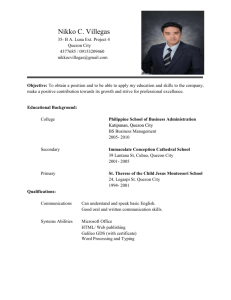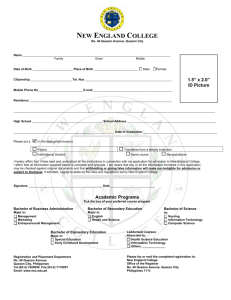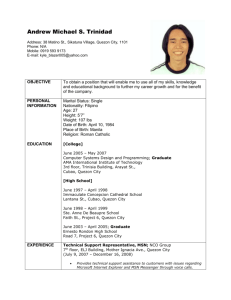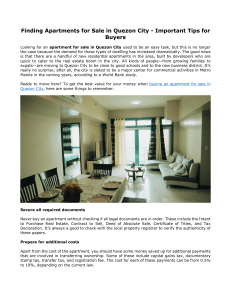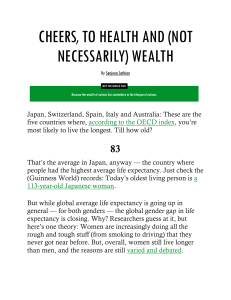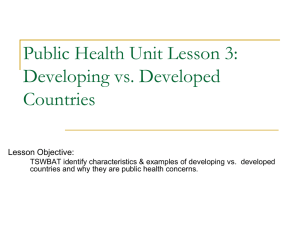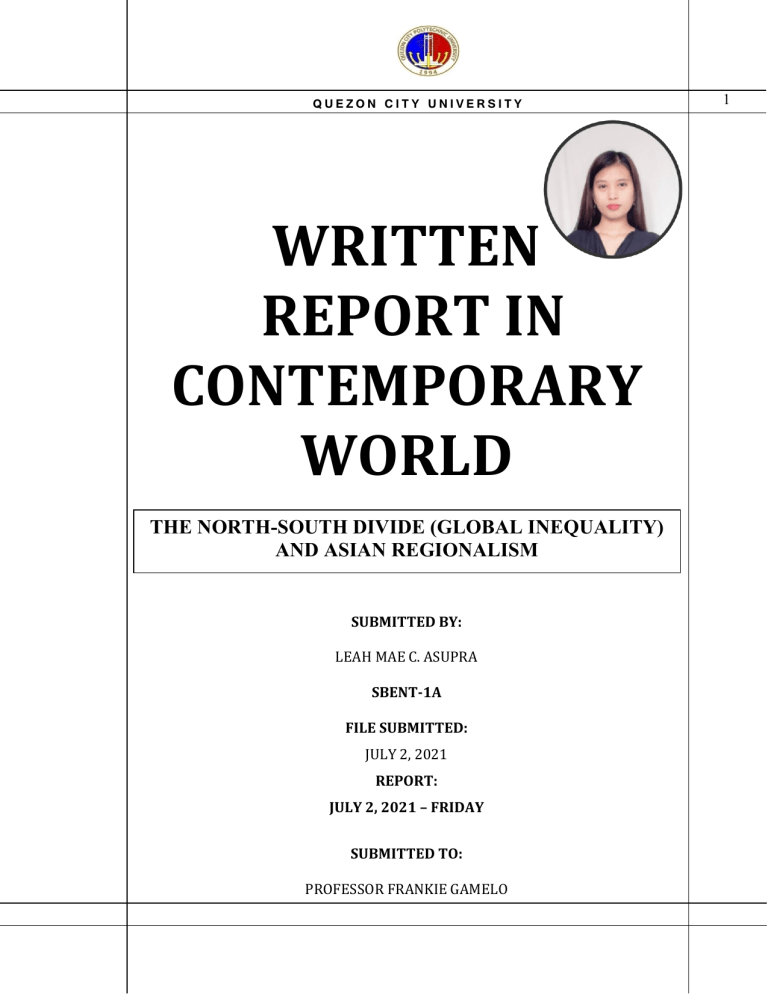
QUEZON CITY UNIVERSITY WRITTEN REPORT IN CONTEMPORARY WORLD THE NORTH-SOUTH DIVIDE (GLOBAL INEQUALITY) AND ASIAN REGIONALISM SUBMITTED BY: LEAH MAE C. ASUPRA SBENT-1A FILE SUBMITTED: JULY 2, 2021 REPORT: JULY 2, 2021 – FRIDAY SUBMITTED TO: PROFESSOR FRANKIE GAMELO 1 QUEZON CITY UNIVERSITY THE NORTH-SOUTH DIVIDE (GLOBAL INEQUALITY) AND ASIAN REGIONALISM What is Global Inequality? The world is an unequal place. It means that not everybody has the same access to the same rights, opportunities, or quality of life. A good way to understand this is to look at life expectancy. Life expectancy refers to the average years that a group of people are expected to live, based on the year they are born. Let’s look at the life expectancy of a few countries for babies born in 2017: Japan - 85 years Canada - 81 years United Kingdom - 80 years United States - 80 years Pakistan - 68 years Nigeria - 59 years Afghanistan - 52 Years This means that if a baby was born in Japan in 2017, we can expect them to live to about 85 years old (on average). That same baby, if it was born in Afghanistan, could expect to live to about 52 years old (on average). That’s more than 30 years difference! That doesn’t seem very fair or equal. There are many reasons for this difference, and there are many complicated factors involved. Here are just a handful of reasons and causes for global inequality: 2 QUEZON CITY UNIVERSITY 1 - Access to healthcare. Without access to doctors, nurses, medicine, vaccines, and other healthcare needs, people are more likely to die from preventable causes. For example, what could be a simple hospital visit might take days because the hospital is far away. 2 - Economy. Some countries are poorer/richer than others. This means that they might not have roads or hospitals, or schools. Some people are also poorer/richer. It means people might not have jobs or clothing or food. Without a good economy and good jobs, people can’t afford basic needs. 3 - Political stability. Not all places have a stable government. Think of all the ways that your government is involved in your life (jobs, schooling, roads, food production, almost everything!). Without a stable government, it is hard to live in a place that is safe and healthy. 4 - Basic human rights and equality. Not all places have the same basic rights. Some places do not allow women to work or vote. Some places persecute people who are LGBTQ. There might be less rights related to job safety. There might be less rights related to disability. There might be less rights related to being a child, or a senior citizen. These places have a shorter life expectancy, especially for people who are directly affected. 5 - Geography. Some places are more dangerous naturally. If you live in an active earthquake zone, or somewhere extremely cold/hot, or live in a place surrounded by dangerous animals, it can shorten the average life expectancy of that area. 6 - Education and access to information. Education helps people make their own lives better, through jobs and opportunities. It also helps a country become better, with better solutions to their problems. 7 - Access to water, food, and sanitation facilities. Not everyone in the world has access to safe drinking water that isn’t full of bad germs or chemicals. 3 QUEZON CITY UNIVERSITY Not everyone has access to nutritious food. Not everyone has access to proper toilets and sewers. All of these things are important to stay healthy. Let’s Start with the south… ⊹ Economy was based on cotton production which depended on slave labor. ⊹ Southern economy was weak and vulnerable because it depended entirely on cotton but was still very profitable. ⊹ The period of cotton growing was called King Cotton. And the now north… ⊹ Economy was based on industries and major businesses, commerce and finance. ⊹ North had many manufacturing factories that leather, and wooden goods. ⊹ The biggest business of the north was in railroad construction. Transportation was easier because of railroads. NORTH-SOUTH DIVIDE NORTH ⊹ North America, Western Europe, Australia, Japan ⊹ Known as first world ⊹ Home to four of the five permanent members of the United Nations Security Council ⊹ Richer and developed region ⊹ 95% has enough food and shelter and functioning education system as well SOUTH ⊹ Africa, Latin America and Asia ⊹ Poor and Less developed region ⊹ 5% of the population has enough food and shelter ⊹ It serves as a source for raw materials for the north 4 QUEZON CITY UNIVERSITY NORTH SOUTH GAP Term used to describe the economic gap between the rich and northern countries of the world and the south poorer countries of the world DEFINITION: ⊹ During cold war – primary global division was between east and west, predicted upon security and power balance ⊹ After cold war – many see primary global division as being between north and south, and predicated upon economic inequality Comparison between north and south Major difference in north and south: NORTH ➢ Less population ➢ High Wealth ➢ High Standard of Living ➢ High Industrial Development SOUTH ➢ Large population ➢ Low wealth ➢ Low standard of Living ➢ Low Industrial development ➢ Agriculture Characteristic of the North and South Characteristics of the North Characteristics of the South 1/4 of the world's people 3/4 of the world's people 4/5 of world's income 1/5 of world's income 5 QUEZON CITY UNIVERSITY Average life expectancy more than 70 Average life expectancy of 50 years years Most people have enough to eat 1/5 or more suffer from hunger and malnutrition Most people are educated 1/2 of the people have little chance of any education Over 90% of the world's less than 10% of the world's manufacturing industry manufacturing industry About 96% of the world's spending on 4% of the world's research and research and development development Why is the gap between the economic north and south widening? • The richest 1% of the world’s population now receives as much income as the poorest 57%. • Lack of trade. • Lack of aid. • Abundance of debt. • Failure of international organizations (e.g. IMF, World Bank, WTO). • Neo-colonialism. • Adverse climatic conditions. • The difficulty of transforming the established. Closing the Gap: The United Nations has developed a program dedicated to narrowing the divide through its Millennium Development Goals. This includes improving education and health care, promoting gender equality, and ensuring environmental sustainability. 6 QUEZON CITY UNIVERSITY Classifying Countries: ❑ Most Developed Countries (MDCs): the richest of the industrialized and democratic nations of the world. ❑ Less Developed Countries (LDCs): countries with little industrial development, little wealth, and high population growth. ❑ Least Developed Countries (LLDCs): very low per capital income, low literacy rates, and very little in the way of manufacturing industries. REFERENCE: https://www.slideshare.net/Yaqoob63/the-northsouth-gap-m-yaqoob https://intranet.kes.hants.sch.uk/resource.aspx?id=145038 https://kidsboostimmunity.com/what-global-inequality 7
